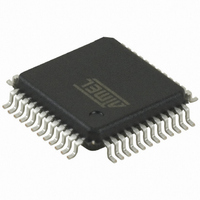AT32UC3B164-AUT Atmel, AT32UC3B164-AUT Datasheet - Page 309

AT32UC3B164-AUT
Manufacturer Part Number
AT32UC3B164-AUT
Description
IC MCU AVR32 64KB FLASH 48-TQFP
Manufacturer
Atmel
Series
AVR®32 UC3r
Specifications of AT32UC3B164-AUT
Core Processor
AVR
Core Size
32-Bit
Speed
60MHz
Connectivity
I²C, IrDA, SPI, SSC, UART/USART, USB
Peripherals
Brown-out Detect/Reset, DMA, POR, PWM, WDT
Number Of I /o
28
Program Memory Size
64KB (64K x 8)
Program Memory Type
FLASH
Ram Size
16K x 8
Voltage - Supply (vcc/vdd)
1.65 V ~ 1.95 V
Data Converters
A/D 6x10b
Oscillator Type
Internal
Operating Temperature
-40°C ~ 85°C
Package / Case
48-TQFP, 48-VQFP
Controller Family/series
AT32UC3B
No. Of I/o's
28
Ram Memory Size
16KB
Cpu Speed
60MHz
No. Of Timers
1
Rohs Compliant
Yes
For Use With
ATSTK600-TQFP48 - STK600 SOCKET/ADAPTER 48-TQFPATAVRONEKIT - KIT AVR/AVR32 DEBUGGER/PROGRMMR770-1008 - ISP 4PORT ATMEL AVR32 MCU SPIATEVK1101 - KIT DEV/EVAL FOR AVR32 AT32UC3B
Lead Free Status / RoHS Status
Lead free / RoHS Compliant
Eeprom Size
-
Available stocks
Company
Part Number
Manufacturer
Quantity
Price
- Current page: 309 of 676
- Download datasheet (11Mb)
21.6.2
21.6.3
21.6.3.1
32059I–06/2010
Receiver and Transmitter Control
Synchronous and Asynchronous Modes
Transmitter Operations
Figure 21-4
and the ISO 7816 clock.
Figure 21-4. Elementary Time Unit (ETU)
After reset, the receiver is disabled. The user must enable the receiver by setting the RXEN bit
in the Control Register (CR). However, the receiver registers can be programmed before the
receiver clock is enabled.
After reset, the transmitter is disabled. The user must enable it by setting the TXEN bit in the
Control Register (CR). However, the transmitter registers can be programmed before being
enabled.
The Receiver and the Transmitter can be enabled together or independently.
At any time, the software can perform a reset on the receiver or the transmitter of the USART by
setting the corresponding bit, RSTRX and RSTTX respectively, in the Control Register (CR).
The software resets clear the status flag and reset internal state machines but the user interface
configuration registers hold the value configured prior to software reset. Regardless of what the
receiver or the transmitter is performing, the communication is immediately stopped.
The user can also independently disable the receiver or the transmitter by setting RXDIS and
TXDIS respectively in CR. If the receiver is disabled during a character reception, the USART
waits until the end of reception of the current character, then the reception is stopped. If the
transmitter is disabled while it is operating, the USART waits the end of transmission of both the
current character and character being stored in the Transmit Holding Register (THR). If a time-
guard is programmed, it is handled normally.
The transmitter performs the same in both synchronous and asynchronous operating modes
(SYNC = 0 or SYNC = 1). One start bit, up to 9 data bits, one optional parity bit and up to two
stop bits are successively shifted out on the TXD pin at each falling edge of the programmed
serial clock.
The number of data bits is selected by the CHRL field and the MODE 9 bit in the Mode Register
(MR). Nine bits are selected by setting the MODE 9 bit regardless of the CHRL field. The parity
bit is set according to the PAR field in MR. The even, odd, space, marked or none parity bit can
be configured. The MSBF field in MR configures which data bit is sent first. If written at 1, the
most significant bit is sent first. At 0, the less significant bit is sent first. The number of stop bits is
selected by the NBSTOP field in MR. The 1.5 stop bit is supported in asynchronous mode only.
ISO7816 I/O Line
ISO7816 Clock
shows the relation between the Elementary Time Unit, corresponding to a bit time,
on TXD
on CLK
ISO7816 Clock Cycles
FI_DI_RATIO
1 ETU
AT32UC3B
309
Related parts for AT32UC3B164-AUT
Image
Part Number
Description
Manufacturer
Datasheet
Request
R

Part Number:
Description:
DEV KIT FOR AVR/AVR32
Manufacturer:
Atmel
Datasheet:

Part Number:
Description:
INTERVAL AND WIPE/WASH WIPER CONTROL IC WITH DELAY
Manufacturer:
ATMEL Corporation
Datasheet:

Part Number:
Description:
Low-Voltage Voice-Switched IC for Hands-Free Operation
Manufacturer:
ATMEL Corporation
Datasheet:

Part Number:
Description:
MONOLITHIC INTEGRATED FEATUREPHONE CIRCUIT
Manufacturer:
ATMEL Corporation
Datasheet:

Part Number:
Description:
AM-FM Receiver IC U4255BM-M
Manufacturer:
ATMEL Corporation
Datasheet:

Part Number:
Description:
Monolithic Integrated Feature Phone Circuit
Manufacturer:
ATMEL Corporation
Datasheet:

Part Number:
Description:
Multistandard Video-IF and Quasi Parallel Sound Processing
Manufacturer:
ATMEL Corporation
Datasheet:

Part Number:
Description:
High-performance EE PLD
Manufacturer:
ATMEL Corporation
Datasheet:

Part Number:
Description:
8-bit Flash Microcontroller
Manufacturer:
ATMEL Corporation
Datasheet:

Part Number:
Description:
2-Wire Serial EEPROM
Manufacturer:
ATMEL Corporation
Datasheet:











